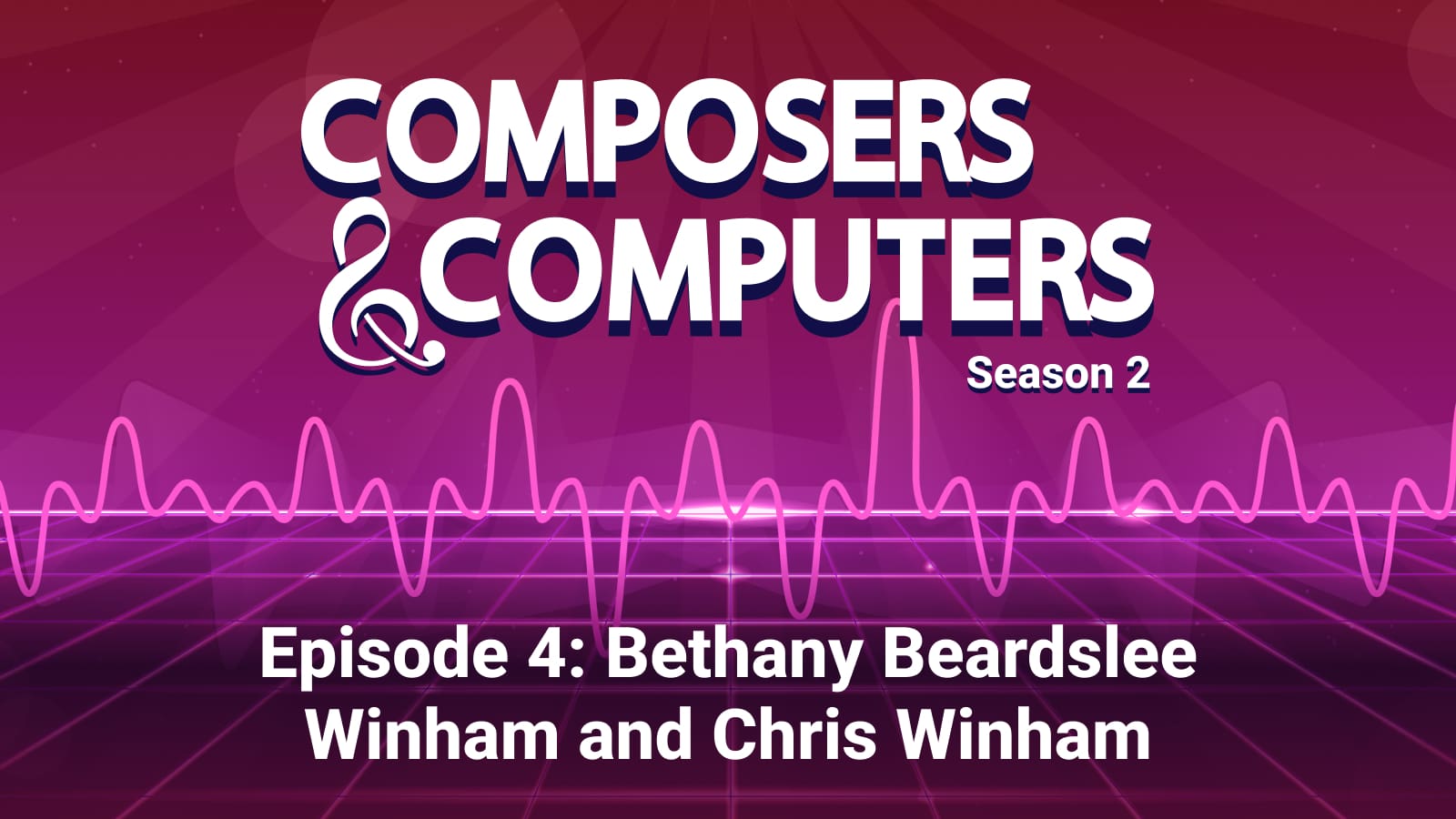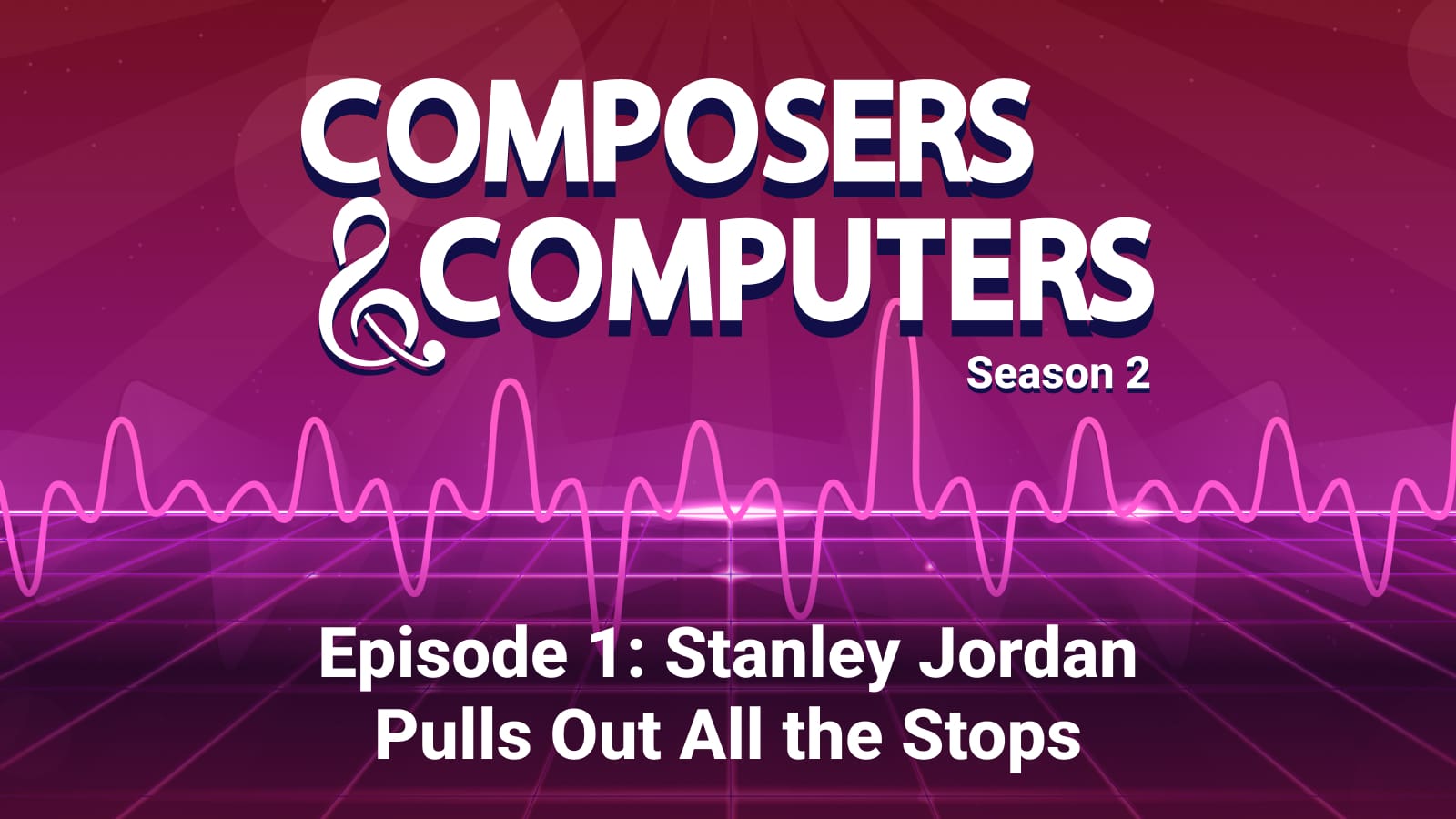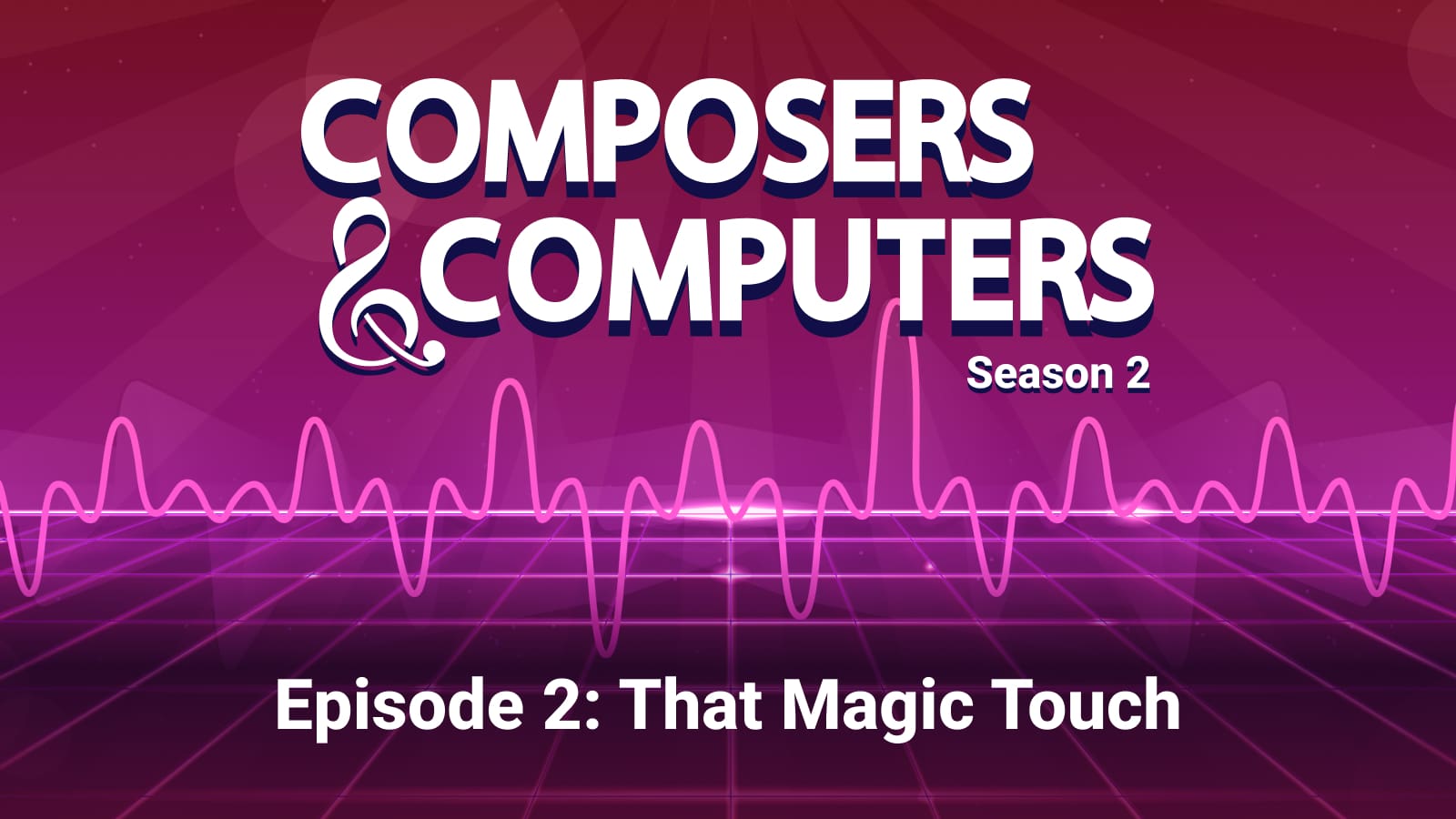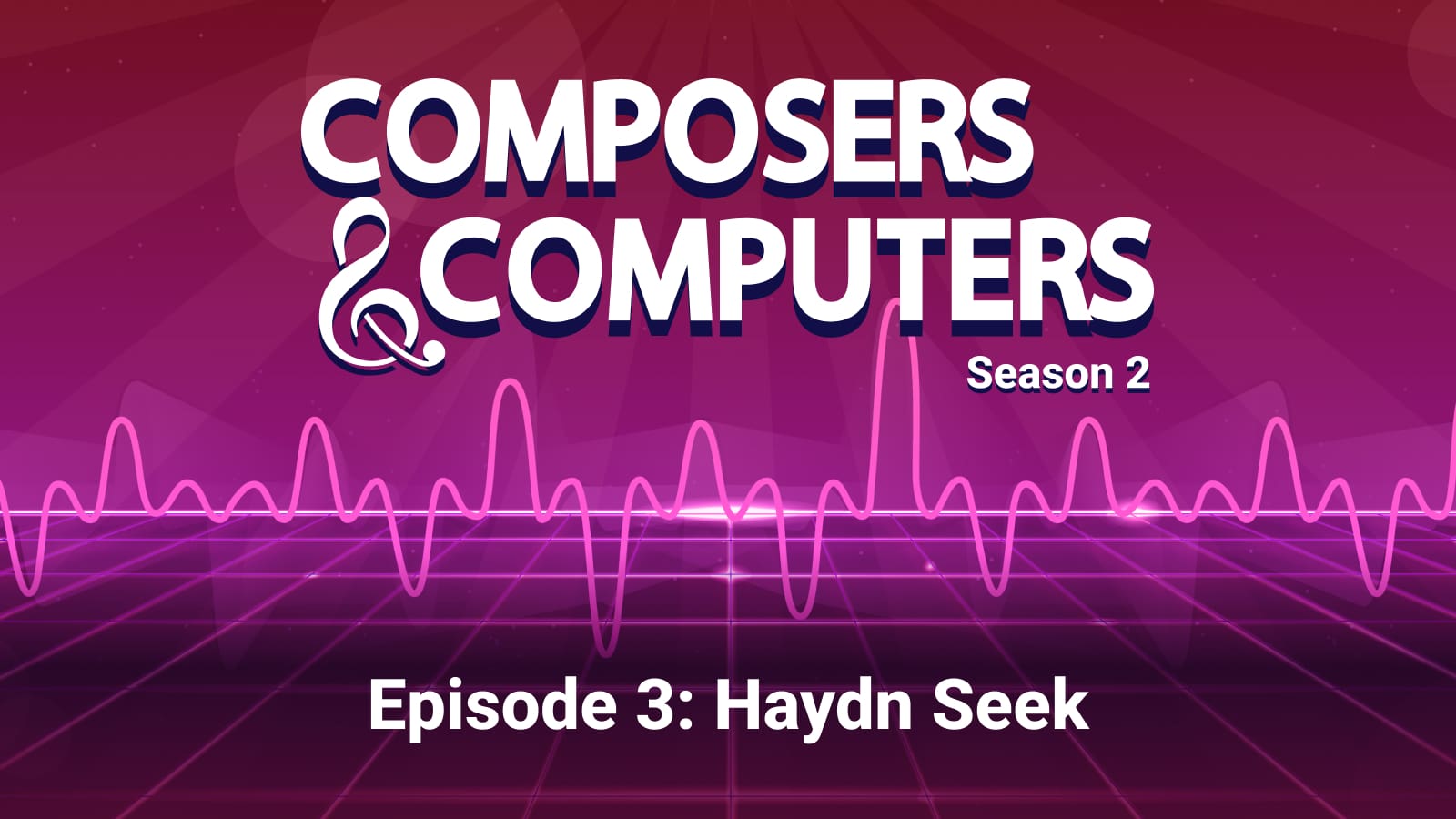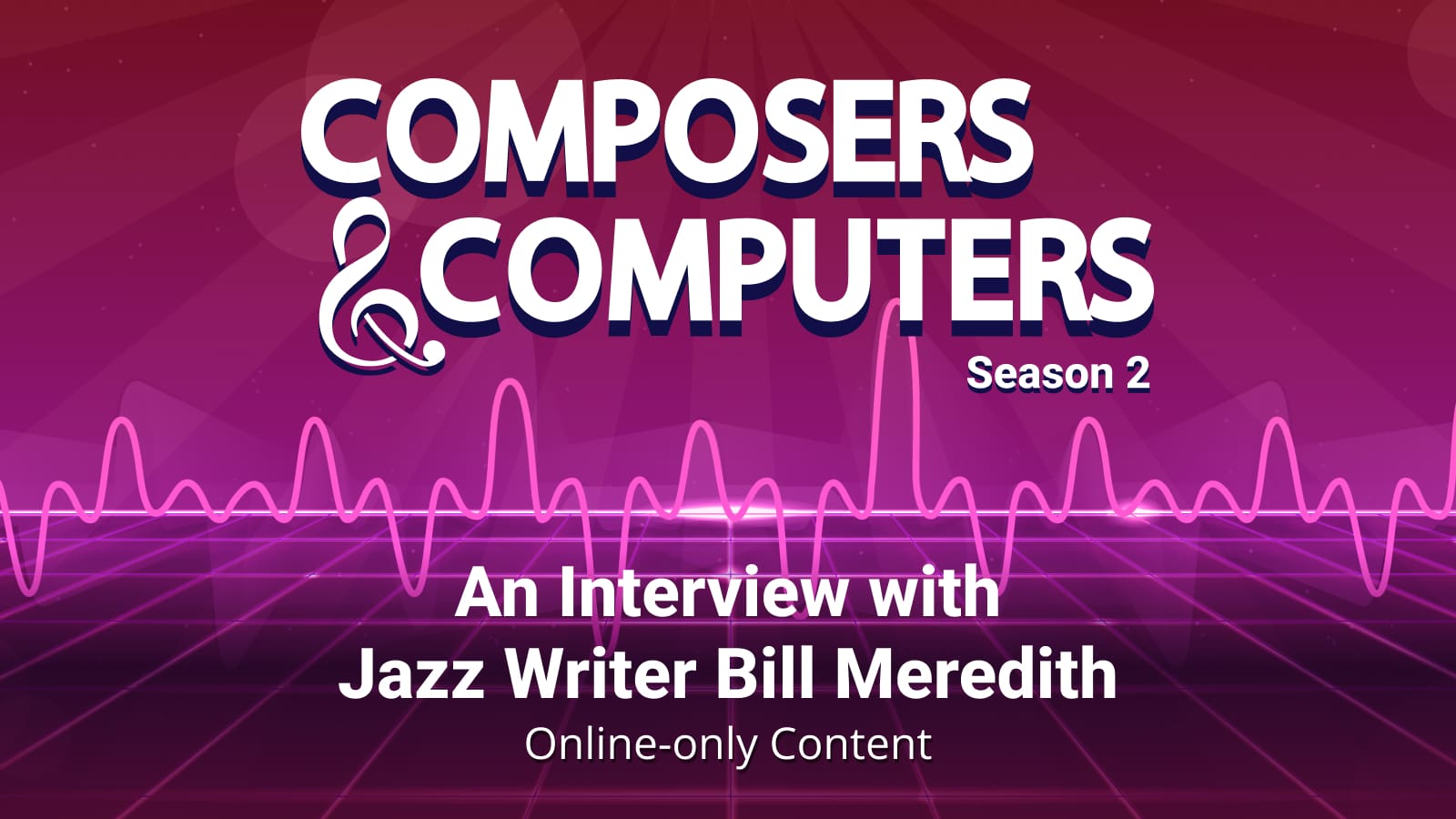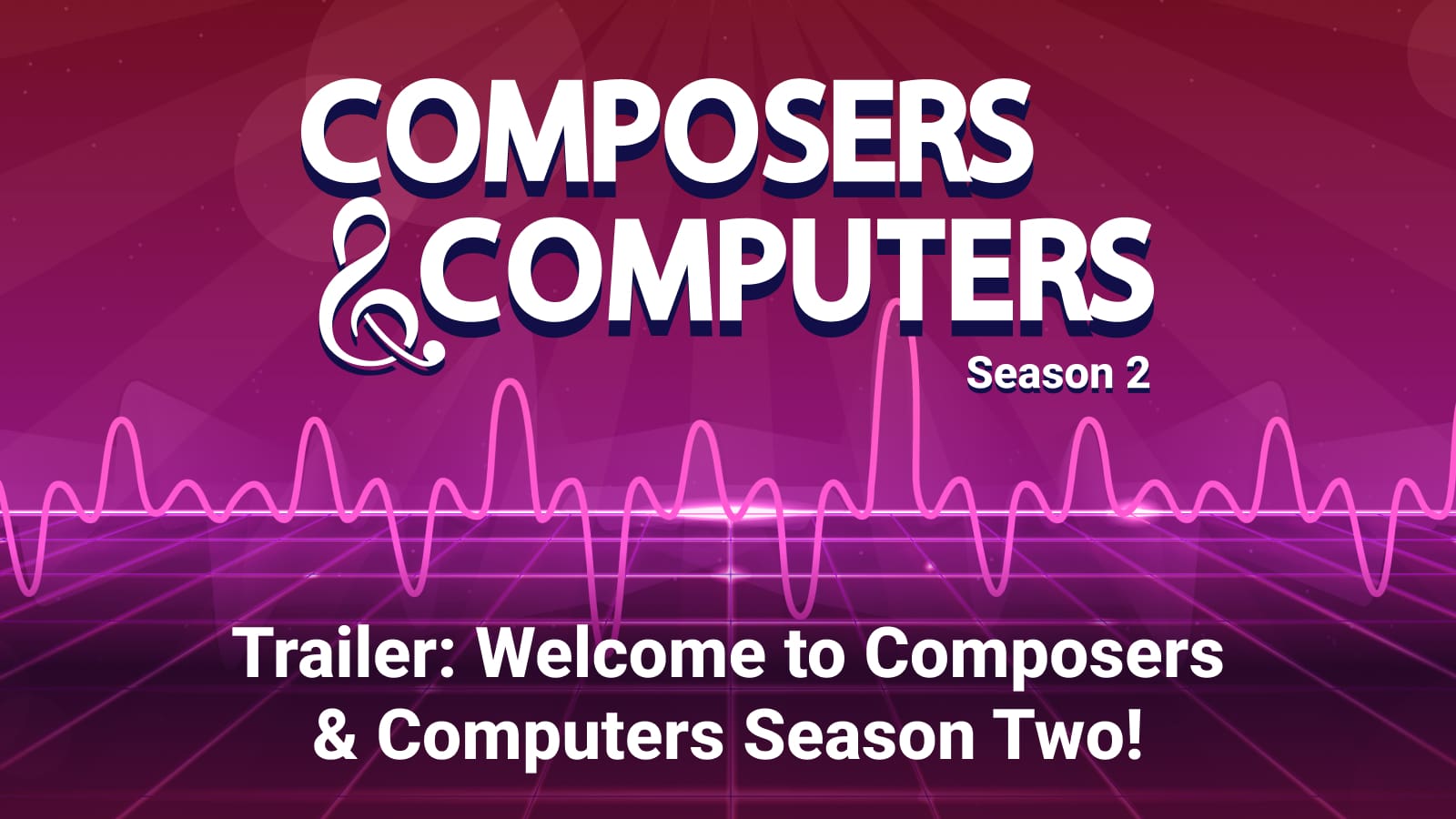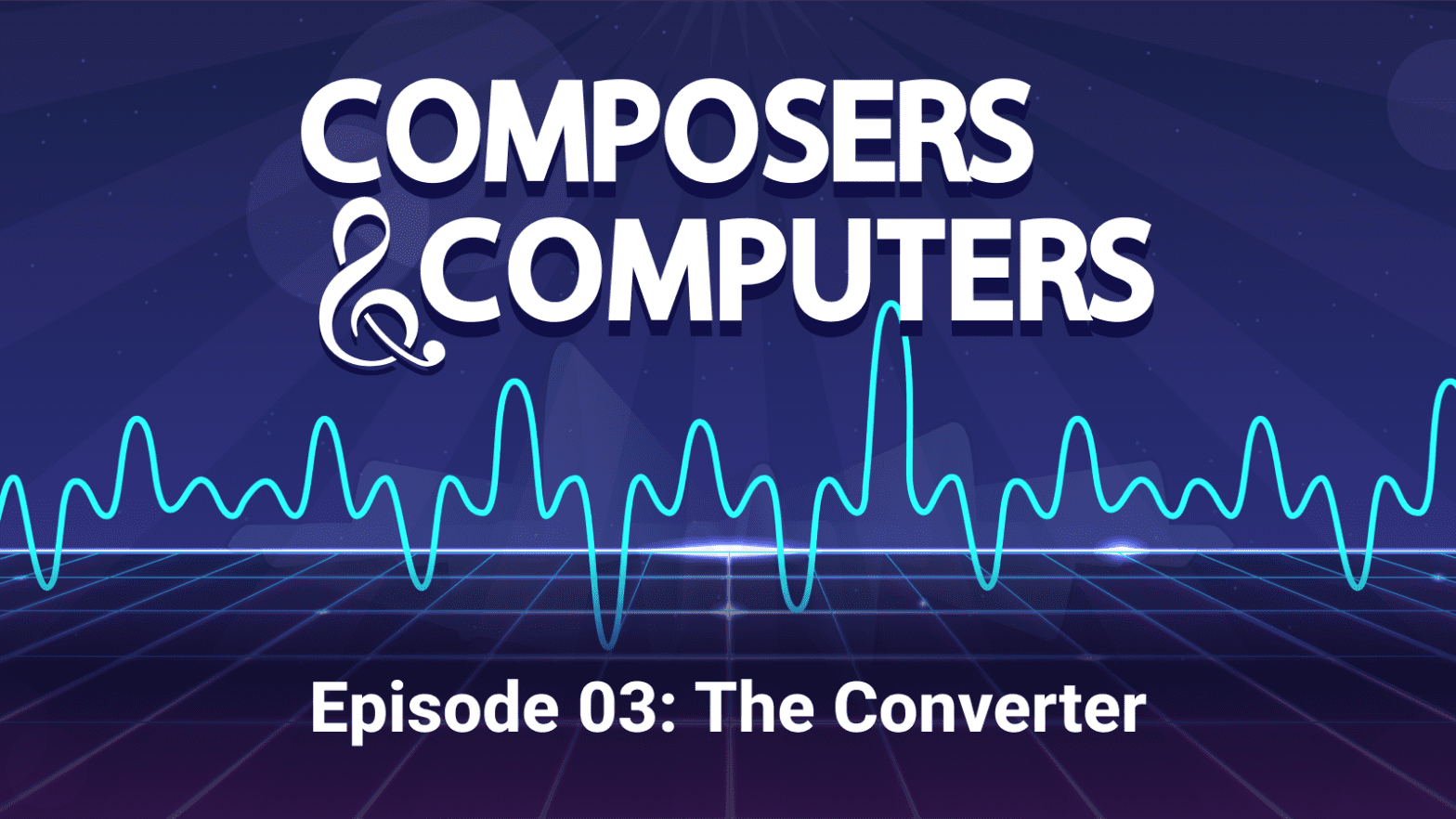
Episode 3: The Converter
By
on
This is from the series Composers & Computers, a podcast
Imagine using a computer to synthesize music, but not being able to hear it as you built it. That’s how it was in the 1960s – musicians only heard what they were composing in their mind’s ear, until the project, usually riddled with mistakes, was finished and processed at a far-off lab.
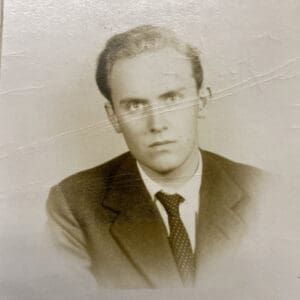
This presented a challenge to the Princeton interdisciplinary team of engineer Ken Steiglitz and composer Godfrey Winham. They worked to build a device that would translate the ones and zeros generated by the IBM in the Princeton Computer Center into analog sound, the only form of sound human beings can hear. The work they did together represented a watershed in the use of computers as a tool to create music.
Winham saw the potential of the computer as a musical device, and spent his best years building tools to make the giant machine more user-friendly to musicians. And Steiglitz was uniquely positioned to help Winham realize his vision.
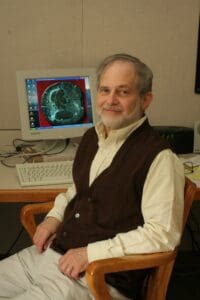
This episode is the poignant story of their teamwork, as well as of the community of composers that created a wild batch of music on the IBM, music that has largely been long forgotten. But we’ve found it, and there are lots of clips of that music in this episode. We’ll take a look at the science of how humans are able to hear digital music. And we’ll explore the amazing story of Godfrey Winham, Princeton’s first recipient of a doctorate in music composition. Beyond his advances in music generation software, digital speech synthesis, and the development of reverb for art’s sake, he was a fascinating character.
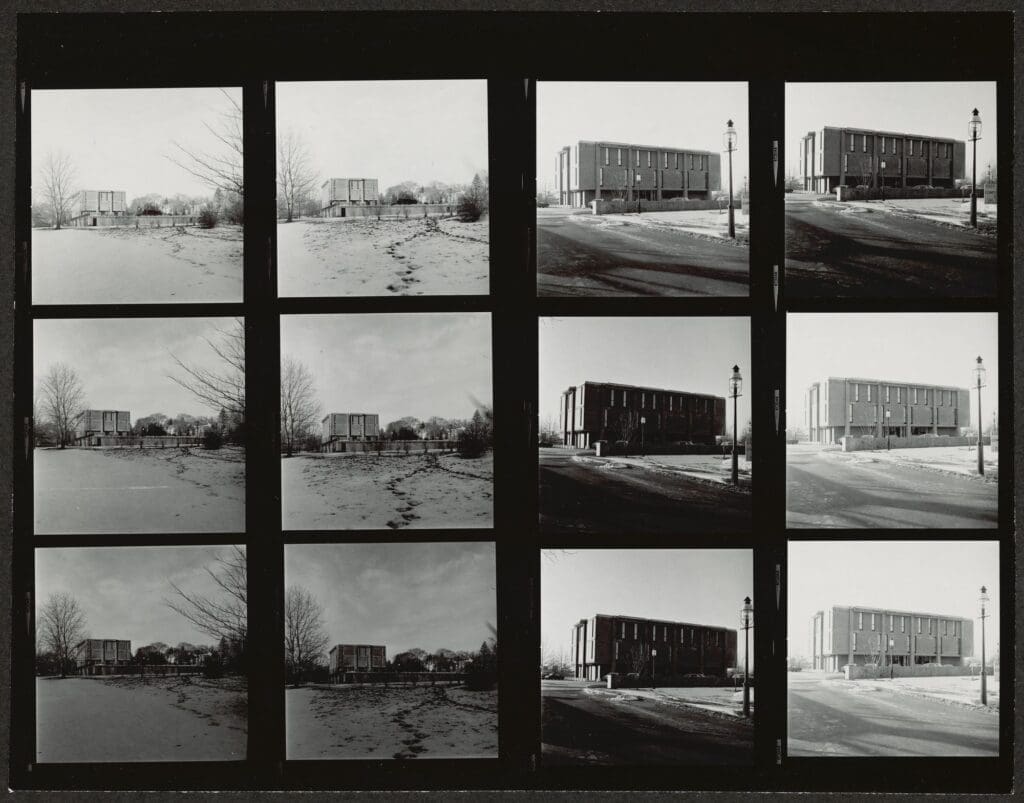
List of historical music played in this episode:
Fünf Klavierstücke, Op.23., Arnold Schoenberg
“Variations on a Theme by James Pierpont,” Godfrey Winham
“NP,” Godfrey Winham
“Aspects of 3 Tetrachords,” Ric Graebner
“P-Vibes, Three Canons,” Joel Gressel
“Bete-Noire,” Frank Brickle
“91 Plus 5 for Brass Quintet and Computer,” John Melby
“Earth’s Magnetic Field,” Charles Dodge
“String Quartet #4, Op. 37 – III. Largo,” Arnold Schoenberg
Sources (other than interviews):
“I Sang the Unsingable: My Life in Twentieth-Century Music,” Bethany Beardslee, 2017
“The Music Theory of Godfrey Winham,” David Leslie Blasius, 1997.
“The Importance of Being Digital,” Paul Lansky, 2004
“The Discrete Charm of the Machine,” Kenneth Steiglitz, 2019
Transcript:
Aaron Nathans:
It was late 1963, and Ken Steiglitz, a new assistant professor in the electrical engineering department of Princeton was lost in the sprawling new unfamiliar Engineering Quadrangle when he heard jarring sounds coming from behind an unmarked door. He looked inside and saw the racket was coming from loudspeakers attached to a refrigerator-sized rack of electronics and a digital tape drive. It was clear that the two men trying to work this device, well, they were lost too.
Aaron Nathans:
These men were not engineers. They were members of the music faculty. Godfrey Winham and James Randall had just synthesized music on the building’s big new IBM computer. And now they were trying, struggling to hear it. The IBM didn’t make sound on its own. To hear it, they would need a device that would translate the IBM’s ones and zeros into sound, that is from digital into analog form. They could drive 45 minutes to Bell Labs to get the conversion done there. But the folks at Bell had donated this old converter to Princeton to try to save them the trip. However, the secondhand device broke easily. The composers were flummoxed. And standing in the doorway, just by chance, was one of the few people in the world who knew how to fix it. Talk about serendipity. In that moment, a mighty interdisciplinary research team was born. Together, in the decade to come, Ken Steiglitz and Godfrey Winham would make big strides in digital music. This episode is that story. <>
Aaron Nathans:
From the School of Engineering and Applied Science at Princeton University, this is Composers and Computers, a podcast about the amazing things that can happen when artists and engineers collaborate. I’m Aaron Nathans.
Part Three, The Converter.
Aaron Nathans:
Godfrey Winham was born in London in 1934 into an exceptionally wealthy family. His father was a real estate executive. The classical music writer Hans Keller took this teenage musical prodigy under his wing, teaching him how to properly listen and how to write reviews. In 1952, at the Salzburg Music Festival in Austria, Keller introduced Winham to a mutual friend, Princeton music professor Milton Babbitt. We covered Babbitt in the first episode of this podcast. Winham was accompanied at this festival by his mother. That’s how young he was at the time. He had come to the festival because of his strong interest in the Viennese composer Arnold Schoenberg, originator of 12-tone serialist music. <> It was an interest Winham shared with Babbitt.
Aaron Nathans:
Babbitt was impressed by Winham’s intellect and proposed that he come to Princeton to study with him. Babbitt was so taken with this young talent that after the festival, he went to Winham’s home in London to discuss the arrangement with his parents. Babbitt and his wife, Sylvia, returned to America by boat with Winham in late August of that year. Godfrey Winham received his bachelor of arts degree from Princeton in 1956, his MFA in 1958, and in 1964, he was awarded the university’s first doctoral degree in music composition. Along the way, he married one of Babbitt’s collaborators, the famed soprano Bethany Beardslee.
Aaron Nathans:
Winham had followed Babbitt to the Columbia Princeton Electronic Music Center in Manhattan to work with the RCA Mark II synthesizer, an early, mostly analog device, that was the first electronic machine upon which a musician could compose music. But Manhattan wasn’t exactly next door to Princeton where Winham and his family lived. When the Engineering Quadrangle and the new computer center opened, Winham was among the first composers to try out the IBM 7090 to see if it could be used as a tool in the service of creating music. Babbitt was happy with what the Mark II could do and had no interest in working with the computer.
Aaron Nathans:
Many of the young computer musicians, including a young Paul Lansky, had been taking computer music classes with Godfrey Winham. If you were a computer musician, chances are you intersected in some way with Godfrey Winham, perhaps regularly, and chances are you have a good Godfrey Winham story. Paul Lansky.
Paul Lansky:
Yeah. He was an interesting character. He was sort of an oddball. He smoked like a fiend and he was very thoughtful. I took some seminars with him and he was good in seminar.
Aaron Nathans:
How so?
Paul Lansky:
He was very, very open-minded.
Aaron Nathans:
In her autobiography, Bethany Beardslee wrote that Winham was shy and avoided small talk. He walked around with the smallest pencil sharpener he could find in his pocket so that he would always have something good to write with. He worked in a pair of shredded shoes, a cashmere cardigan, a soft plaid cotton shirt, and, as she wrote, “Pants worn until the seat shone.” She said his interests included his work, philosophy, logic, music theory, game theory, poker, and the game Go. He invented games and read entire mystery novels at bedtime. They had two sons who knew not to bother him when he was working, which was often. The British composer had worked with fellow Princeton composer Hubert Howe in the Princeton Computer Center to build a more composer-friendly version of music generation software, building on the work done by the music-loving engineers at Bell Labs. Hubert Howe.
Hubert Howe:
Godfrey was a guy who, as I say, he’s independently wealthy. As Jim Randall said, his father owned England. He would sort of go to bed when the sun was coming up, sleep till about two in the afternoon, and then right around seven or so, he’d wind up to the computer center.
Aaron Nathans:
After they completed the composing software, the computer changed. So they did it again, coding a second revision in the computer language of Fortran, so by this point, Winham really knew his way around the computer.
Aaron Nathans:
He owed a lot of what he knew to Ken Steiglitz, the electrical engineering professor. Steiglitz was born in 1939, growing up in West New York, New Jersey and getting his bachelor’s and doctorate degrees in electrical engineering from New York University. In one of his books, “The Discrete Charm of the Machine,” Stieglitz recalls as a child finding large discarded radios on the sidewalk, bringing them home and dissecting them to see how they worked.
Aaron Nathans:
Let’s go back to that scene when Steiglitz encountered Winham and Randall for the first time with the broken digital-to-analog converter. Steiglitz looked at the device and knew that it was capable of processing digits that were among roughly 4,000 possibilities. The digits that the two music professors had fed into the machine were beyond that range. So Steiglitz suggested scaling those digits down, and with that help, they got the converter working for the time being. In his book, Steiglitz said that his first collaboration with the music faculty left him with the feeling of having landed on a South Pacific island in a giant silver bird.
Aaron Nathans:
Winham and Steiglitz became great friends. Steiglitz would cue Winham into technological details that Winham could use to improve how the computer rendered music, and Winham would take it from there, figuring out how to implement them himself. He would hear things from Steiglitz and then go learn them. For example, Stieglitz told Winham that to really develop computer music, he would need to learn about the field of complex variables. So Winham did. Ken Steiglitz.
Kenneth Steiglitz:
More or less, I would see Godfrey very regularly. We would have dinner every Monday night. And when we weren’t playing chess over dinner, we would be discussing these technical questions. We were learning from each other. Yeah, we had a lot of mutual interests. He was interested in the foundations of mathematics and logic, and I would ask him about music.
Aaron Nathans:
Steiglitz had been teaching digital signal processing to undergraduates in the early 70’s. And he said his conversations with Winham affected what he was teaching in that class. Winham’s conversations with Steiglitz surely informed what he was teaching as well. Winham had a whimsical side. On Winham’s compilation album, there’s a series of compositions called “Variations on a Theme by James Pierpont,” several extended reimaginings of “Jingle Bells” named for the composer Pierpont. <> Mark Zuckerman.
Mark Zuckerman:
Godfrey wrote that because his son said, after listening to some of the music that Godfrey wrote. “Can’t you do something simple?” So he wrote this extended set of variations on “Jingle Bells,” which is really incredible. That occupied Godfrey for quite a while. I remember going over to his house as he played what he had available. You know, what was next? It was charming.
Aaron Nathans:
Mark Zuckerman arrived at Princeton in 1970 and received his doctorate in music in 1976. He worked closely with Winham and Steiglitz on technical matters of music. Although Winham was a composer, his major contribution to computer music was the technical work. Charles Dodge.
Charles Dodge:
This probably took the place of his creative endeavors. He found that he had a lot of people who depended on him and who liked him and who appreciated his efforts. I think he really found a place where he was useful and was something that he enjoyed doing.
Aaron Nathans:
Dodge described Winham as shy, disheveled, kind and helpful. He would spend a lot of time helping others work their way through the technical barriers. Another composer who had Winham as his advisor, Frank Brickle, said the most important thing he learned from Winham was not to become bamboozled by complexity. Winham told Brickle to ask the question, “Is this really as convoluted as it first appears? Isn’t there a simpler way to look at this?”
Aaron Nathans:
Brickle will remember the night he first met Winham. It was in the computer center. He sat down at a table with a few other composers in the ready room, waiting for their jobs to finish. And they played bridge. He played Winham’s hand while Winham got up to check on his job. It was a great hand, and they exchanged a subtle smile. When Winham returned, he had found an error in his job and he looked over the code while he continued to play bridge. He also took a call every once in a while. It was quietly pointed out to Brickle that Winham was multitasking, playing bridge, debugging his program, and playing a game of blindfold chess at the same time. That’s what he was doing on the phone. He was exchanging moves with his opponent verbally. There was no board.
Aaron Nathans:
That’s how his mind worked. Godfrey Winham loved solving puzzles, and the biggest puzzle of all at that point was finding a way for this team of composers to get past their biggest hurdle: the inability to hear the music the computer was creating without having to spend the day driving to and from Bell Labs.
Aaron Nathans:
By this point, the computer was in a different location. The Princeton University Computer Center had grown into a bustling center of activity with 33 full-time equivalent employees, and campus officials knew it was time to expand. In 1969, the center moved out of the EQuad and into its own $2.2 million building at 87 Prospect Avenue, outfitted with a special cooling system to keep the machinery at a constant temperature and humidity. Water was circulated into the computer to keep it from overheating, a practice that has become more common today. The main machine at the new computer center was a 1.6 gigabyte IBM, 360/91, 14 times as much memory as the original 7090 model that had been in the EQuad, but still representing just a fraction of the storage within the devices we carry in our pockets today.
Aaron Nathans:
The new supercomputer worked a lot faster than the old one. A job that had taken four or five hours before now took maybe half the time. But people were now running much bigger jobs. Powerful as it was, the machine was still not set up to convert sound from ones and zeros into something human beings could hear. As we mentioned before, Bell Labs had gifted the Princeton composers an older digital-to-analog converter, but it was unreliable. Steiglitz had helped them patch it up temporarily, but it kept breaking, and after a while, the composers gave up on trying to fix it. That meant that for the time being the composers still had to schlep over to Bell Labs in Murray Hill, New Jersey, 45 minutes away if they wanted to get their digital tape converted into analog form. D-to-A converters were very rare at the time. Stanford University had a converter too, but that was hardly a day trip. Winham figured rather than trying to fix the old secondhand converter, it would be better to build one of their own. Mark Zuckerman.
Mark Zuckerman:
So we considered it would be a terrific advantage to have a conversion laboratory right on campus, and that’s what we went about building.
Aaron Nathans:
Steiglitz said Winham had the idea to use a so-called mini computer, not small by today’s standards, but smaller than the mainframe at the computer center, and to turn that mini computer into a digital-to-analog converter. He decided to try to use a Hewlett-Packard 2116C. It was roughly the size and shape of a microwave oven. Ken Steiglitz.
Kenneth Steiglitz:
And so he arranged, he wrote a program that would convert. It would go digital-to-analog and also analog-to-digital. So it was called D-A-A-D, or DAAD. So we called it DAAD. He wrote the program without being able to test it, by the way. I mean, these days we write a program, it doesn’t work, we write a program, it doesn’t work. You know, we do it 50 times and then it finally works. That’s how kids learn how to program. The idea of sitting down for a week and writing a complicated and tricky program and checking it without being able to test it is unthinkable today. But he wrote the program. I can tell you a little bit. I mean, maybe I can give you an idea of how tricky it is.
Kenneth Steiglitz:
Timing. The time that it takes for the instructions to execute is crucial because there’s what’s called a circular buffer involved. So the beginning of the buffer, where the sound is kept before it’s converted, wraps around and if it wraps around too much, it overlaps with the beginning. That’s disastrous. So everything has to be timed so that by the time the tail is chasing the head, so the head has to keep ahead of the tail and go around in a circle. And if the tail ever catches up with the head, the whole thing breaks and doesn’t work right. He had it all worked out, well, in those days by milliseconds. It takes so many milliseconds for this to happen. So many milliseconds. And he had it all worked out and he was not writing in a high level language. He was writing an assembler code for the Hewlett-Packard.
Kenneth Steiglitz:
I don’t think that he’d ever written a program in that language before. So not only he didn’t have a chance to test the program, he couldn’t test his knowledge of the language or anything. He, from complete scratch, wrote this program and checked it mentally to make sure that it was right with all this tricky business, which would be hard to get right for any anybody today, even. He made an appointment. We made an appointment to drive up to Northern Jersey to visit the Hewlett-Packard place. The engineers agreed that we could run this program there to see whether it worked. And we drove up there. He punched the program into their paper tape machine and read it in. And it worked the first time, which I always thought was one of the miracles of computer science that should be recorded in the religious texts of the discipline.
Aaron Nathans:
Soon, they’d have an HP mini computer of their own in the EQuad basement, paid for by a grant from the National Science Foundation. With Winham’s program installed and streamlined by Mark Zuckerman, they started converting the tapes from the computer center across the street. What used to take composers a 45-minute drive in both directions. Now took them a walk of about five minutes. Here’s composer Joel Gressel.
Joel Gressel:
Ken had a recording of something like a Schumann symphony or something on the tape. He played it back through the converter and he said, “This is really good. It’s as good as FM radio. This is going to work.” And it was this kind of moment.
Aaron Nathans:
The converter used every bit of power the Hewlett-Packard mini computer had to read the tape and push the data through the converter. But his Hail Mary pass aside, Godfrey didn’t get the converter working by himself. In order to get it working, he needed a low-pass filter that would filter out the analog frequencies that go too high. Steiglitz designed the filters and Winham them built them. Ken Steiglitz.
Kenneth Steiglitz:
You know, it was a continual give and take because really, musicians learn things when they grow up and electrical engineers learn things when they grow up. This was a point where the two paths converged, so we could share experience. But I don’t know if it was significant in the way that discovering the helical structure of DNA was, but it was an adventure. It was not something that was done much anywhere. He didn’t have anybody to call up and say, “Oh, how do you do this?” It was all-
Aaron Nathans:
He had you.
Kenneth Steiglitz:
Yeah.
Aaron Nathans:
We’ll be right back with more of Composers and Computers. If you’re enjoying this podcast, you might want to check out our other podcast, which also deals with technology. “Cookies: Tech Security & Privacy” deals with the many ways technology finds its way into our lives, in ways we notice, and in ways we might not. If you’re looking to shore up the security of your personal data and communication, you’ll find some great tips from some of the best-informed people in the business. You can find “Cookies” in your favorite podcast app or at our website, engineering.princeton.edu, that’s engineering.princeton.edu.
Aaron Nathans:
We’re halfway through the third of five episodes of this podcast, “Composers & Computers.” On our next episode, we’ll examine the work of Paul Lansky, perhaps the best known of the computer musicians to have come out of Princeton. But let’s not get ahead of ourselves. Here’s the second half of part three of Composers and Computers.
Aaron Nathans:
With the ability to now hear music on site, the crew of composers at the computer center picked up the pace. Paul Lansky recalled the sound was deafening when the converter was all powered on.
Paul Lansky:
Well, the big thing that changed was that the conversion facilities were not at Bell Labs anymore. They were in Princeton. So you could have a much richer experience. You didn’t have to drive 40 miles to hear your work.
Aaron Nathans:
You just had to walk across the street.
Paul Lansky:
Yeah.
Aaron Nathans:
Zuckerman says the first computer piece put through the Princeton converter may have been “NP,” one of Godfrey Winham’s earliest computer music compositions that appears to be his only surviving recording within the computer music genre. It wasn’t released on record until years later. <>
Aaron Nathans:
Zuckerman said that the title of the piece is understood to have been a nod to a popular question in computer science dealing with wicked problems, the most difficult problems to solve. It’s such an important question, it’s built in brick, into the backside of the Princeton computer science building. It poses the question, if the solution to a problem is easy to check for correctness, is it also easy to solve on its own? If it seems a little complex… Well, that’s the point. But then again, Howe said Winham may simply have meant “NP” to mean new piece. Lansky says he remembers it to mean non-programmable. In any event, the converter worked, and that short musical work, “NP,” could be heard after the tape was run through the converter, and that signaled a big change in what was possible for these composers. Here’s Mark Zuckerman, who ran the conversion facility.
Mark Zuckerman:
This way you could turn it around that day or the next day at any rate because people would call me up at all hours to come over there and play it. That helped the creative process significantly, and it encouraged a number of people to get involved who might otherwise have been discouraged. Imagine what it would be like as a graduate student, for example, rather than a member of the faculty. The faculty knows that they’re going to be around there for years. So they could take five years to write a piece, even if they were going to be having to wait a week to be able to hear the results and graduate students wouldn’t have that luxury. So now you have the ability to actually get your feet completely wet in computer music because we had that facility on campus.
Aaron Nathans:
Once word got out that Godfrey Winham had invented a digital-to-analog converter, demand poured in from across campus and beyond. Mark Zuckerman.
Mark Zuckerman:
But you’re right. I mean, as soon as there was a way of being able to use a mini computer set up to perform the D-to-A conversion, it made it available to a number of other people. I went out to the University of Washington, for example, to build a D-to-A conversion lab so that they could do computer music. And there are other people who did similarly.
Aaron Nathans:
With the converter making the creative process easier, more composers were showing up at the computer center. Zuckerman recalled spending late nights playing bridge there with fellow composers Joel Gressel, Richard Meckstroth, and Frank Brickle. Also around at the time, he said, were Howe and John Melby. There was Rick Cann. Lansky was also spending more time there, and he remembers visitors from other institutions like composers Jonathan Harvey and Ric Graebner, both from England. Graebner had one of the first complete, substantial pieces to be run through the new converter. Here’s an excerpt from that piece, which he generously sent us. “Aspects of Three Tetrachords.”<> Paul Lansky.
Paul Lansky:
One of the exciting things working with the computer is that I’d work side by side with the graduate students and the other graduate students, and we’d go to the D-to-A converter together and we’d listen to each other’s work. So you were sort of working at the same desk as some other people, and that was exciting. It was a lively community and you would get ideas that you wouldn’t normally think of. So it was an exciting, exciting time.
Aaron Nathans:
Composer Joel Gressel’s work is interesting, not only for the quality of the product, but the fact that he’s made computer music a lifetime effort. He arrived at Princeton as a grad student in 1965. Two years later, he left town and then returned in 1970 to do his Ph.D. in computer music, and took a couple of computer music courses with Jim Randall. Joel Gressel.
Joel Gressel:
It’s easier to tell the computer what to do, at least for me, than a group of performers. Like, it’s hard for me to tell a barber how to cut my hair, so I do it myself. It was the same way with performers. It was just some special place where I was on my own, but I think I just wanted to make music that was different and special.
Aaron Nathans:
This is Joel Gressel’s “P-Vibes, Three Canons.”<> With the inability to hear his music as he was creating it, Gressel’s work included a lot of mistakes, but he ended up incorporating many of those mistakes into the finished pieces. Joel Gressel.
Joel Gressel:
The half of the mistakes are advantageous.
Aaron Nathans:
Why?
Joel Gressel:
You end up with something you didn’t expect. But it’s really interesting, or you never would’ve… Like, some of the instruments were mistakes. Like, I meant to multiply something by the frequency, but forgot. So it was tiny, tiny numbers filtering some sound. It was so tiny, it turned into a vibraphone. I never would’ve expected it.
Aaron Nathans:
To this day, Gressel still uses MUSIC 4B, the same program he used at Princeton way back in the day.
Aaron Nathans:
Here’s some music from another fellow from around the bridge table, Frank Brickle, circa 1979. This is “Béte Noire,” composed as part of his PhD dissertation on the IBM 360/91 in the computer center. He used MUSIC 4B, software created by Godfrey Winham and Hubert Howe. He converted it from digital to analog using Winham’s device. <>
Aaron Nathans:
John Melby would go on to join the faculty of the University of Illinois at Urbana-Champaign. Here’s his “91 Plus 5 for Brass Quintet and Computer.” <>
Aaron Nathans:
All this music was made possible by Winham’s converter, which Ken Steiglitz noted had just 16 kilobytes of memory. That memory cost roughly $16,000 or $1,000 per kilobyte. To put that into perspective, Ken’s current home computer, an older Dell laptop, has 16 gigabytes of RAM, or a million times more memory for a fraction of the cost. It’s a good illustration of Moore’s Law. Moore’s Law was coined by Gordon Moore who founded Intel in 1965. It’s basically an observation that the number of transistors that fit in a microchip doubles every two years. This basically remained true until recent years. Computers were getting more powerful, little by little, which would have massive implications later on. Ken Steiglitz.
Kenneth Steiglitz:
Underneath this is a boiling cauldron of energy called Moore’s Law. Chips went from four transistors to 4 billion transistors, 400 billion transistors, and that’s still hard for me to grasp. That was driving everything. I mean, everything that happens today was completely impossible without Moore’s Law.
Aaron Nathans:
As the campus computer grew progressively more powerful, Steiglitz and Winham collaborated in an increasing number of areas. In the summer of 1970, Winham took what he learned from Steiglitz and offered a weekly group to teach digital signal processing. Through the use of filters, Steiglitz and Winham, and later Paul Lansky, were able to provide the musicians with a richer quality of sound. For instance, reverb.
Aaron Nathans:
The sound speaking to a large, empty room. <>
Aaron Nathans:
… was a new phenomenon when applied to computer generated sound. They drew upon research from Bell Labs to create software that generated the reverb effect. Composer Charles Dodge used what he learned from Winham about reverb to go back to Columbia and realize his work, “Earth’s Magnetic Field.” <> Charles Dodge.
Charles Dodge:
You know, what was wonderful about Princeton was the engineering aspect. Way ahead of most places, was Ken Steiglitz and Godfrey Winham and their experiments with reverberation and filters. That was, I guess, reverberation was a filter. The way that they made those available to composers to play with was for me just a watershed, a really meaningful change in the way that computers could be used.
Aaron Nathans:
One of the more interesting collaborations between Steiglitz and Winham was work on getting computers to make the sounds that exist between the notes: for instance, what you might hear between C… and C sharp… Or as Steiglitz called it, how to play in the cracks. Steiglitz said this can come in handy when trying to digitally replicate the human voice. Ken Steiglitz.
Kenneth Steiglitz:
But what if you wanted a pitch in between? What if you wanted to slide from one pitch to another, which is done all the time, of course, in music, and singing especially. So it turns out that there’s a very neat way to do that, which is based on a mathematical identity, which is the sum of the frequencies you want up to certain point. You don’t necessarily have to restrict yourself to having a pulse at one sample and then 0, 0, 0, 0 and then a pulse at another sample and so on. You can fill all that in and get pitches in between.
Aaron Nathans:
They published a research paper on it in February of 1970, and typical to Winham, it was only a few paragraphs long. Manipulating speech was of special interest to Winham because he had been married to one of the most noted vocalists of their generation, Bethany Beardslee. Steiglitz and Winham had done some early experiments in synthesizing the human singing voice, but these tapes have been lost. Here’s Mark Zuckerman talking about Winham.
Mark Zuckerman:
Yeah. One of the things that he thought would be funny would be to have somebody who couldn’t sing suddenly be able to sing in like a seven-octave range. So they came up with this piece, which was, which he spoke, which said “This work was done 20,000 Samples Under the Sea.” Okay. That was what he called the laboratory. And so he synthesized his voice going up and singing this aria, “This work was done 20,000 Samples Under the Sea.” I can’t even begin to replicate it. But that, I think, was where he was aiming.
Aaron Nathans:
In June of 1974, Charles Dodge, by now on the faculty at Columbia, organized the musical program at the second annual computer art festival at the venue The Kitchen in New York. Over a two-week period, dozens of computer musicians, including many of the ones we’ve discussed in this podcast, attended to play their creations. Max Matthews, the engineer known as the father of computer music, presented his own music, as did his former colleague at Bell Labs and early computer music innovator, Jean-Claude Risset. Even John Chowning of Stanford, whose landmark FM synthesis technology powered the creation of the Yamaha digital keyboard, he was there too.
Aaron Nathans:
But one name was not on the list: Godfrey Winham. We can’t say definitively that he was absent, but in her book, Bethany Beardslee notes that sometime during that month, she departed for New England for work, leaving Winham alone with their kids. When she returned in August, she was alarmed by his physical appearance. He’d been having night sweats and he looked tired. She insisted that he go to the doctor.
Aaron Nathans:
What at first appeared to be a case of mononucleosis turned out to be Hodgkin’s disease, a form of lymphoma. Beardslee set up the bedroom so he could stay home, listen to music, and visit with friends to keep his spirits up. Visitors flooded in. He propped up on pillows and played bridge with friends in bed. Paul Lansky brought him a pile of records. Winham had a short remission in February of 1975. But then the chemotherapy started. Mark Zuckerman.
Mark Zuckerman:
So he had radiation and chemotherapy and he was dreadfully sick. He was bedridden and he wasted away to virtually nothing.
Aaron Nathans:
That April, Milton Babbitt visited him. He was apprehensive. But Winham immediately put him at ease by starting a diatribe against his sickening course of treatment. He then began a long explanation of a computer piece he was planning. It was to be a computer synthesized soprano voice. He went on to expound on the music he’d been listening to, and finally, back to the topic they both loved to discuss, composer Arnold Schoenberg. It was the topic that first brought them together in Salzburg in 1952. It was the last time Babbitt saw him. Godfrey Winham died on April 23rd, 1975 at the age of 40.
Hubert Howe:
Last I saw him, it must have been a month or so before he died. We were very close. I was really affected by his passing there. But I don’t know what you could do. You know, our understanding of cancer and treatments for it are much better now than they were then.
Aaron Nathans:
Was he in denial to some extent that he was sick?
Hubert Howe:
No, I don’t think so. I think once he realized that he was not denying anything, but it was really too late. And then I think that he went in, he had radiation or something like this, and the radiation is probably what ultimately killed him.
Aaron Nathans:
Wow.
Hubert Howe:
Because it was too much, you know? I don’t know. They probably can do better now. Chemotherapy might be better.
Aaron Nathans:
Mark Zuckerman.
Mark Zuckerman:
It was tragic. It was tragic.
Aaron Nathans:
Ken Steiglitz.
Kenneth Steiglitz:
Yeah. It’s very painful because… It’s too bad. He had Hodgkin’s lymphoma and unfortunately really good treatments for that have been developed since, but he missed the boat and it was a difficult time, very difficult time. I used to visit him and he was a chess enthusiast. I mean, he was a very good chess player, much, much better than I was. So if we played, we would adjust the clock so we were about equal. So he would get five minutes; I would get half an hour, you know, something like that. He was much better. And even then he would crush me.
Kenneth Steiglitz:
But he bought a demonstration board, the kind that they use in tournaments. I don’t know whether you’ve ever seen them. Somebody stands. It’s sort of like a big, huge whiteboard with a chess board on it and magnetic pieces that you can slide around. And so we used to play that way when he was in bed. Some of the last memories I have of him are Monday nights, again, but we’d still be playing chess, but he would be bedridden and I would visit.
Kenneth Steiglitz:
Yeah, it was devastating. I don’t know what else to say about it, because he was a remarkable… I’m not the only one who’s commented on that. He was just a remarkable individual in many respects. I mean, aside from his intellect, he was just a good guy, too. You know?
Aaron Nathans:
Godfrey Winham left behind a trove of materials, which were compiled in a book, “The Music Theory of Godfrey Winham” by Leslie David Blasius, published by the Princeton University Press in 1997. Most of Winham’s papers are archived at the Princeton University Library. The EQuad basement lab in which he worked was named in his memory, The Winham Lab. That lab would continue to see a steady flow of activity in the years to come, both from a small but devoted set of computer musicians, as well as the students in the course in computer music that the music school would continue to offer annually.
Aaron Nathans:
A number of musical pieces in the coming years, including one from Milton Babbitt, were written in his memory. But as with his life, Godfrey Winham’s legacy lives on in his work, unlocking the possibilities of how a computer can synthesize sound.
Aaron Nathans:
In our next episode, we’ll focus on the work of Paul Lansky, who would pick up Winham’s research into synthesizing the human voice, and he would also create some of the most inventive computer music ever made.
Aaron Nathans:
This has been “Composers and Computers,” a production of the Princeton University School of Engineering and Applied Science. I’m Aaron Nathans, your host, and the producer of this podcast. I conducted all the interviews. Our podcast assistant is Mirabelle Weinbach. Our audio engineer is Dan Kearns. Thanks to Dan Gallagher and the folks at the Mendel Music Library for collecting music for this podcast. Graphics are by Ashley Butera, and Steve Schultz is the director of communications at Princeton Engineering.
Aaron Nathans:
This podcast is available on iTunes, Spotify, Google Podcasts, Stitcher, and other platforms. Show notes, including a listing of music heard on this episode, sources, and an audio recording of this podcast are available at our website engineering.princeton.edu. If you get a chance, please leave a review. It helps. The views expressed on this podcast do not necessarily reflect those at Princeton university. Our next episode should be in your feed soon. Peace.
